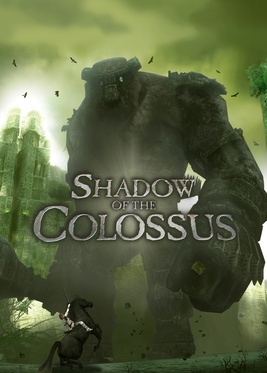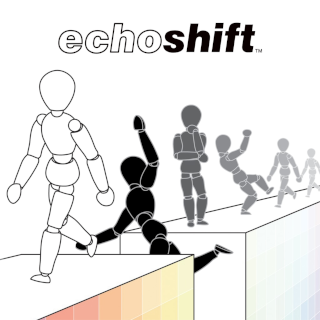The DualShock is a line of gamepads developed by Sony Interactive Entertainment for the PlayStation family of video game consoles. It is named for vibration-feedback and analog controls. It was introduced in November 1997 as a secondary peripheral for the first PlayStation console. The console's bundle was updated to include DualShock, and phase out the original PlayStation controller and the Dual Analog Controller. The DualShock is the best-selling gamepad of all time by units sold, excluding bundled controllers.

Jumping Flash! is a platform video game developed by Exact and Ultra and published by Sony Computer Entertainment for the PlayStation. It was released on 28 April 1995 in Japan, 29 September 1995 in PAL territories and 2 November 1995 in North America. It was re-released through the PlayStation Network store on PlayStation 3 and PlayStation Portable in 2007, in 2012 on PlayStation Vita and again in 2022 on PlayStation 4 and PlayStation 5.

Shadow of the Colossus is a 2005 action-adventure game developed by Japan Studio and Team Ico, and published by Sony Computer Entertainment for the PlayStation 2. It takes place in a fantasy setting and follows Wander, a young man who enters an isolated and abandoned region of the realm seeking the power to revive a girl named Mono. The player assumes the role of Wander as he embarks on a mission that might entail Mono's resurrection: to locate and destroy the colossi, sixteen massive beings spread across the forbidden land, which the protagonist traverses by horseback and on foot.

Ape Escape is a series of video games developed primarily by Japan Studio and published by Sony Computer Entertainment, starting with Ape Escape for PlayStation in 1999. The series incorporates ape-related humour, unique gameplay, and a wide variety of pop culture references. The first game in the series is the first game to have made the DualShock or Dual Analog controller mandatory.
Various accessories for the PlayStation 3 video game console have been produced by Sony and third-party companies. These include controllers, audio and video input devices like microphones, video cameras, and cables for better sound and picture quality.

LSD: Dream Emulator is a 1998 exploration game by Asmik Ace Entertainment that released for the PlayStation. In LSD, the player explores surreal environments without any objective. The player can only move and touch objects that will warp them to another setting. The game was conceived by Japanese artist Osamu Sato, who rejected the idea of games, and wanted to use the PlayStation as a medium for creating contemporary art. The game's concept is based on a dream diary kept by an Asmik Ace employee for over a decade.

The PlayStation Eye is a digital camera device, similar to a webcam, for the PlayStation 3. The technology uses computer vision and gesture recognition to process images taken by the camera. This allows players to interact with games using motion and color detection as well as sound through its built-in microphone array. It is the successor to the EyeToy for the PlayStation 2, which was released in 2003.

God of War III is an action-adventure hack and slash video game developed by Santa Monica Studio and published by Sony Computer Entertainment. First released for the PlayStation 3 on March 16, 2010, it is the fifth installment in the God of War series, the seventh chronologically, and the sequel to 2007's God of War II. Loosely based on Greek mythology, the game is set in ancient Greece with vengeance as its central motif. The player controls the protagonist Kratos, the former God of War, after his betrayal at the hands of Zeus, King of the Olympian gods, whom he learned was his father. Reigniting the Great War, Kratos ascends Mount Olympus until he is abandoned by the Titan Gaia. Guided by Athena's spirit, Kratos battles monsters, gods, and Titans in a search for Pandora, without whom he cannot open Pandora's Box, defeat Zeus, and end the reign of the Olympian gods to have his revenge.

Echochrome is a 2008 puzzle game created by Sony's Japan Studio and Game Yarouze for PlayStation 3 from the PlayStation Store and for PlayStation Portable (PSP). The gameplay involves a mannequin figure traversing a rotatable world where physics and reality depend on perspective. The world is occupied by Oscar Reutersvärd's impossible constructions. This concept is inspired by M. C. Escher's artwork, such as "Relativity". The game is based on the Object Locative Environment Coordinate System developed by Jun Fujiki—an engine that determines what is occurring based on the camera's perspective.

Gran Turismo 5 Prologue is a 2007 racing simulation video game developed by Polyphony Digital and published by Sony Computer Entertainment for the PlayStation 3. It is the eighth overall installment in the Gran Turismo series. Gran Turismo 5 Prologue is a precursor to Gran Turismo 5, in celebration of the series' tenth anniversary.

Space Harrier II is the sequel to Space Harrier, developed and published by Sega. First released on October 29, 1988, it was one of the original launch titles released for the Mega Drive in Japan and one of the six Sega Genesis launch titles in the United States the following year. It was also later released on the Wii's Virtual Console in December 2006, and on the Nintendo Switch Online + Expansion Pack in April 2022. Like Altered Beast, another launch title for the Mega Drive, Space Harrier II features digitized human voice recordings during gameplay, and is also an example of some of the Mega Drive's early sound, composed by Tokuhiko Uwabo. A graphically enhanced version included with the Sega Genesis Mini 2 was released October 2022.
PlayStation is a video gaming brand that consists of five home video game consoles, two handhelds, a media center, and a smartphone, as well as an online service and multiple magazines. The brand is produced by Sony Interactive Entertainment, a division of Sony.

The PlayStation 2 (PS2) is a home video game console developed and marketed by Sony Computer Entertainment. It was first released in Japan on 4 March 2000, in North America on 26 October 2000, in Europe on 24 November 2000, and in Australia on 30 November 2000. It is the successor to the PlayStation (console), as well as the second installment in the PlayStation brand of consoles. As a sixth-generation console, it competed with Nintendo's GameCube, Sega's Dreamcast, and Microsoft's Xbox. It is the best-selling video game console of all time, having sold over 155 million units worldwide, nearly triple the combined sales of the Dreamcast, GameCube, and Xbox.
God of War is an action-adventure game franchise created by David Jaffe and developed by Sony's Santa Monica Studio. It began in 2005 on the PlayStation 2 (PS2) video game console and has become a flagship series for PlayStation, consisting of nine installments across multiple platforms. Based on ancient mythologies, the series' plot follows Kratos, a Spartan warrior who becomes the God of War and comes into conflict with various mythological pantheons. The earlier games in the series are based on Greek mythology and see Kratos follow a path of vengeance against the Olympian gods; the later games are based on Norse mythology and see Kratos go on a path of redemption while also introducing his son Atreus as a secondary protagonist.

The PSX is a Sony digital video recorder with a fully integrated PlayStation 2 home video game console. It was released in Japan on December 13, 2003. Since it was designed to be a general-purpose consumer video device, it was marketed by the main Sony Corporation instead of Sony Computer Entertainment and does not carry the usual PlayStation branding. Initial sales were strong, with the console selling 100,000 units during its first week, thus selling out. Its high cost, however, resulted in poor sales later on, prompting Sony to cancel plans to release the PSX outside Japan. After the price had been lowered in September 2004, sales increased again.

PlayStation Move is a motion game controller developed by Sony Interactive Entertainment. Initially released in 2010 for use with the PlayStation 3 home video game console, its compatibility was later expanded to its successor, the PlayStation 4 in 2013, its PlayStation VR platform in 2016 and the PlayStation 5 in 2020. Conceptually similar to Nintendo's Wii Remote and Microsoft's Kinect, its function is based around controller input in games stemming from the actual physical movement of the player. The Move uses inertial sensors in the wand to detect motion while the wand's position is tracked using a PlayStation Eye or PlayStation Camera. The device was generally well received by critics, but has not quite met Sony's goals for integration into the market.

Echoshift is a 2009 puzzle video game for the PlayStation Portable and PlayStation Vita. The game uses events known as "Time Bounces" in which a small section of time repeats itself over and over again. By exploiting time bounces, the player can overcome various obstacles that would have been otherwise impossible to navigate. The game is a spinoff of the Echochrome series.

PlayStation Move Ape Escape, simply titled Ape Escape in Europe and known in Asian countries as Ape Escape On The Move, and in Japan as Furi Furi! Saru Get You, is a 2010 rail shooter and party video game developed by Sony Computer Entertainment's Japan Studio and published by Sony Computer Entertainment for the PlayStation 3 video game console. The game was originally announced at the Tokyo Game Show 2009 as one of the title supporting the PlayStation Move controller. The title was released on December 9, 2010, in Japan, then in 2011 on June 24 for Europe, and on July 5 for North America. An English version of the game in Asia was also released January 31, 2011.

Time Crisis: Razing Storm, known in Japan as Big 3 Gun Shooting, is a compilation of light gun rail shooter video games by Namco for the PlayStation 3. Featuring full compatibility with both the GunCon 3 light gun and the PlayStation Move motion control system, the compilation consists of ports of various arcade games. Developed by Nex Entertainment and published by Namco Bandai Games, the compilation was released in 2010 in North America on October 19, and in Japan on October 21, which is the launch date of the PlayStation Move in Japan. It was released as part of a bundle with the PlayStation Move, PlayStation Eye and the Shooting attachment for the PlayStation Move in Japan and other Asian countries.

PlayStation Move Heroes, known in Japan as Gachinko Heroes, is a 2011 action-adventure video game developed by Nihilistic Software and published by Sony Computer Entertainment for the PlayStation 3 video game console utilizing the PlayStation Move. It is a crossover of the Ratchet & Clank, Jak and Daxter, and Sly Cooper franchises to form a total of six main characters.















